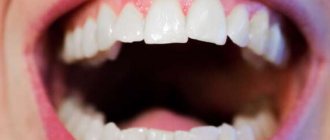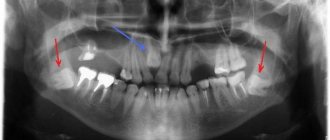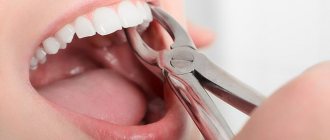Causes of pain
The further a tooth is in the row, the more difficult it will be to remove, as it has a more extensive root system. This often leads to inflammation and improper healing of the hole. According to statistics, complications are most often diagnosed after the removal of wisdom teeth (eight teeth). Also, the cause of long-term toothache is the lack of experience of the dental surgeon and incorrect removal tactics.
Let's look at the main complications that lead to long-term pain after tooth extraction:
- Bleeding – Bleeding normally stops within 30 minutes of surgery. But in people with diseases of the hematopoietic system, diabetes mellitus, the hole may bleed for several hours. The critical period is the first day. If you experience even slight bleeding during this time, consult your doctor. He will perform additional tamponade, diathermocoagulation or suturing of blood vessels.
- Alveolitis is a common infectious complication that is characterized by inflammation of the soft tissue around the socket. There are aching pains that intensify while eating. As the disease progresses, pain may radiate to the temple and ear on the affected side. Treatment by a dentist is required. Untimely treatment can lead to the development of an abscess and blood poisoning.
- Paresthesia is a loss of sensation that occurs when the mandibular or maxillary nerve is injured. Normally, the numbness goes away within 1 or 2 weeks. To reduce the period, physiotherapeutic methods are used. If discomfort persists for more than a month, you need to contact the dentist.
- Leaving tooth fragments in the wound - foreign objects in the socket interfere with the normal healing process, which leads to prolonged pain and inflammation. Small fragments may come out on their own when rinsing. X-ray diagnostics are required.
- An abscess is a purulent process that occurs in a hole as a result of infection. Accompanied by throbbing pain, fever, headache, and weakness. An opening and drainage of the abscess and antibacterial therapy are required.
- Osteomyelitis is an inflammation of the bone tissue of the jaw. Accompanied by acute pain, unpleasant odor, mobility of adjacent teeth, and swelling of the jaw. Pathological changes in bone tissue are visible on x-rays. In advanced cases, surgical treatment is required. Without treatment, the infection can spread to the soft tissues of the face and neck.
The most common cause of long-term pain after tooth extraction is the absence of a blood clot, that is, a “dry socket.” This pathology is often observed in older people, smokers and in patients with hormonal disorders.
Pain as a result of tooth extraction
Pain in the jaw and adjacent tissues, radiating to the throat or ear, is a fairly common complaint. However, there is no reason to worry - this phenomenon is considered normal during a very painful process. Damage to nerves, tissues, and mucous membranes leads to open wounds. In this regard, pain arises, which is of a natural nature and manifests itself until recovery.
- Wisdom tooth hurts
Important ! As a rule, the pain goes away within a couple of days.
Pain in the ear due to an extracted tooth is a common occurrence.
If you have such symptoms, doctors recommend taking anesthetics (it’s better to ask your dentist which ones are right for you) and wait until the pain goes away.
How to relieve pain at home
For the first 2–3 days, pain and discomfort are a normal reaction of the body to injury. When removing sevens or eights (wisdom teeth), pain can be felt for up to 5 days. In addition, it can cover the entire jaw and radiate into the ear. This is normal if the pain decreases over time.
To speed up the gum restoration process, it is recommended:
- Do not apply heat to the painful jaw area. It is better to apply a cold compress, which will relieve inflammation and stop bleeding.
- Try not to eat on the injured side; food and drink should be at a comfortable, warm temperature.
- Rinse your mouth after every meal. It is better to use herbal decoctions with an antiseptic effect. It is also advisable to use pharmaceutical antimicrobial agents for rinsing.
- Until the hole has healed, do not use aggressive mouth rinses and toothpastes.
- Do not remove the blood clot or touch the socket.
If the pain is severe, you can take analgesics or non-steroidal anti-inflammatory drugs. They will not only reduce pain, but also relieve swelling.
Anesthesia for tooth extraction
There are several types of pain relief:
- local anesthetics that are injected into the gums;
- drugs for general anesthesia injected into a vein;
- inhalation anesthesia;
- nitrous oxide sedation.
The choice of method depends on what kind of operation is being performed: simple or complex. Removing the front teeth is considered the easiest. They have one root and are easily dislocated with forceps. For pain relief, a simple “freezing” with a local anesthetic is sufficient.
Removing lower wisdom teeth is the most difficult procedure, especially if there are abnormalities in growth and location. It will require cutting the gums, cutting off part of the bone, sawing and step-by-step removal of root fragments. The operation can last more than 1 hour, so it is often performed under anesthesia.
Sedation with nitrous oxide does not exclude local anesthesia. It relaxes well, puts the patient into a state of half-asleep, and reduces fear. Often used in pediatric dentistry to remove baby teeth.
Drugs injected into a vein completely turn off consciousness for a certain period of time. The duration of anesthesia is adjusted by the dosage of the medication.
Inhalation anesthesia allows you to control the dose of the drug directly during the procedure. This ensures high-quality and safe general anesthesia and minimizes the risk of side effects.
When a doctor's help is needed
If you have the following symptoms, you should contact your dentist:
- if bleeding from the socket does not stop within 24 hours after tooth extraction;
- increased body temperature, weakness, headache;
- swollen lymph nodes;
- heavy bleeding, in which the patient has to change the cotton swab every 10-15 minutes;
- redness and swelling of the soft tissues near the hole, which are accompanied by acute, ongoing pain;
- severe numbness of the jaw;
- mobility of adjacent teeth;
- the appearance of bad breath;
- purulent discharge from the socket;
- formation of an abscess on the gum;
- liquid nasal discharge can occur when the maxillary sinus is injured as a result of difficult removal.
All these conditions require qualified medical care.
Why can odontogenic sinusitis occur?
The maxillary (maxillary) sinus is a cavity with bony walls that is located inside the upper jaw. The cavity communicates with the nasal cavity through the anastomosis, which is located on the side wall of the sinus facing the nasal cavity. The lower wall has contact with the upper teeth. Quite often (in about 15% of cases) the apex of the tooth root lies directly under the mucous membrane of the bottom of the maxillary sinus, and there is no bone septum between them.
When an infection enters the maxillary sinus, inflammation of its mucous membrane or sinusitis occurs.
There are two ways of infection:
- rhinogenic - through the nasal cavity. In this case, the infection penetrates from the nasal cavity through natural or artificial (after surgery) communication;
- odontogenic - through the tooth or tissue around it.
Odontogenic sinusitis most often develops slowly against the background of chronic infection in the area of the tooth root. As a result of chronic inflammation, a cyst forms in the root area, which destroys the barrier between the sinus and the tooth. Pathogenic microbes gradually penetrate the sinus mucosa, causing inflammation.
Also, odontogenic sinusitis can occur as a result of the actions of the dentist. Often, after the removal of the upper tooth, the thin barrier between the sinus and the oral cavity may be damaged. As a result, a gateway for dental infection appears. In this case, the anatomical features of the patient with a thin bone septum between the sinus and the tooth root or its complete absence are of key importance.
Infection can occur when cleaning the canals and filling them. In some cases, the filling material gets inside the sinus, causing the formation of fungal sinusitis, and the zinc contained in the filling material promotes the growth of mold fungi (Aspergillus, Mucora). Also, odontogenic sinusitis can develop after the sinus lift procedure and the installation of dental implants in the upper jaw.
Treatment methods
The treatment regimen depends on the cause of the pain, symptoms and severity of complications. After examination, X-ray diagnostics are used to clarify the diagnosis. It allows you to assess the condition of bone tissue and identify the presence of tooth fragments or root remains in the wound.
- Local treatment
Includes tight tamponade, use of a hemostatic sponge for heavy or prolonged bleeding. To relieve inflammation in the absence of complications, the doctor prescribes rinsing with antiseptics and using ointments with an analgesic effect. Aerosols with antimicrobial properties are effective for stomatitis.
- Drug therapy
Includes taking antibiotics for severe extractions, as well as for wisdom teeth removal. In case of loss of sensitivity (paresthesia), vitamin B complexes in capsules or injections are prescribed.
- Physiotherapeutic methods
UHF courses, electrophoresis, and microcurrent therapy help to cope with pain. On average, 10 sessions are recommended. This treatment is prescribed after the hole has healed.
- Surgery
If purulent contents are present, the abscess (abscess) is opened and cleansed. Turunda with a medicinal composition is placed in the wound. In case of a hematoma (accumulation of fluid or blood), an incision is made in the gum under local anesthesia and a drainage is installed. It helps drain the contents of the hematoma. After cleaning the wound, the doctor applies stitches.
You should not let the pathological condition progress and delay it until further surgery. A timely visit to the dental office will allow you to use gentle medicinal treatment methods.
Traditional medicine for ear pain
There are the following folk remedies that can alleviate the condition when ear pain occurs. However, you should not use them without consulting a doctor - they can help well along with the prescribed therapy.
- Aloe or a leaf of pelargonium (geranium) is wrapped in a clean cloth or gauze, crushed to release the juice, and inserted into the ear canal.
- You can drip onion juice or olive oil in small quantities into your ear.
- Before meals, drink lingonberry decoction. To prepare it, a handful of berries are infused in two glasses of boiling water.
- When otitis is diagnosed, you can use celandine tincture as an addition to the main treatment. To prepare it, mix celandine and vodka in the proportion of 20 g of celandine per 100 g of vodka, leave in a cool place protected from light for 10 days. Afterwards they filter. This infusion is applied to a cotton swab and placed in the sore ear.
Folk remedies can help get rid of ear pain
Here's what they recommend doing if you have a toothache (after visiting a doctor, of course).
- Mix a dry collection of chamomile and sage, five tablespoons per glass of hot water, and simmer in a water bath for about 30 minutes. Strain, cool and use for rinsing.
- Plantain juice or infusion - brew in boiling water in the same way (about 1 tablespoon per glass), use for rinsing the mouth. The juice from fresh leaves can be applied to sore gums in the affected area.
Interestingly, people also use a remedy for toothache such as wearing garlic on the wrist. To do this, a garlic clove needs to be ground or finely chopped and tied with a bandage on the inside of the wrist to the hand opposite to the diseased tooth. The effectiveness of this method is explained by the fact that garlic, similar to acupuncture, stimulates bioactive points and, acting on them, reduces the intensity of pain. The main thing to remember is that if itching or severe burning or redness occurs, you need to rinse the skin on your hand well and do not use this method again.
Certain folk methods can relieve pain and inflammation caused by wisdom tooth removal.
If you have agave growing at home, you can use it as a pain reliever. To do this, the agave leaf is washed well, cut and applied to the diseased tooth. However, this method must be used with great caution - agave is considered a poisonous plant that causes allergic reactions, so you can keep this compress for no longer than 5 minutes.
Prevention of complications
Tooth extraction is a radical measure when other treatment methods have proven ineffective. To avoid long subsequent recovery, you must follow your doctor's recommendations.
In the first hours after the procedure, do not smoke or eat. These are important rules that many people ignore, which leads to infection in the socket.
On the day of tooth extraction, do not actively rinse your mouth.
This may damage or flush out the blood clot that helps the socket heal. Do not drink alcohol until the wound is completely healed. Alcohol increases bleeding. Avoid strenuous physical activity, and visiting public places such as swimming pools and lakes is also prohibited. It is impossible to warm up the injured jaw area, so in the first week do not visit the sauna, bathhouse or take a hot bath.










